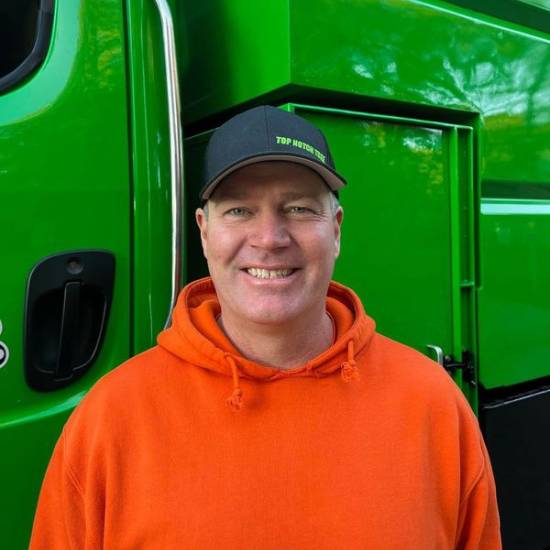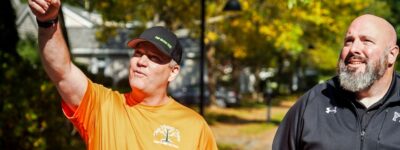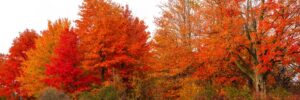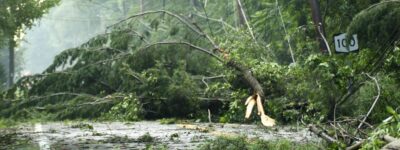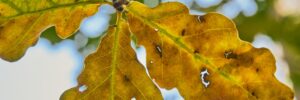Insurance companies across Massachusetts are increasingly using drone surveillance to identify overhanging tree branches. South Shore homeowners are receiving ultimatums: trim your trees or lose your coverage. If you’ve received one of these notices, professional crown raising may be the solution that saves both your insurance policy and your trees.
From the historic estates of Cohasset Village to the coastal properties of Marshfield Ocean Bluff, mature trees that once enhanced property values are now triggering insurance cancellation threats. The key is addressing these concerns with proper arboricultural techniques that satisfy insurers while preserving tree health.
Key Takeaways
- Most insurance tree compliance issues require professional pruning, not tree removal, saving homeowners thousands in property value.
- Insurance companies legally use drone surveillance in Massachusetts, but legitimate notices come directly from your insurer, not third parties.
- DIY tree cutting often violates insurance requirements and can void coverage entirely – professional documentation is essential.
- Certified Arborists provide the risk assessments and compliance documentation insurance companies require for policy protection.
Are Insurance Notices About Drone Surveillance Legitimate?
Yes, insurance companies in Massachusetts are legally allowed to use drone imagery and aerial surveys for risk documentation. CBS Boston reporting confirms that companies are photographing properties without homeowners’ knowledge and using those images to make coverage decisions.
A recent news story made waves about a homeowner who was stuck paying over $1,000 to prune branches or risk losing her insurance.
However, legitimate notices will come directly from your insurance company on official letterhead, not from third-party contractors or unfamiliar companies. Before taking any action, contact your insurance representative to confirm the notice is authentic and verify the specific requirements and timeline for compliance.
Red flags for potential scams include:
- Notices from companies you’ve never heard of
- Demands for immediate payment
- Pressure to sign contracts on the spot
Why Are Insurance Companies Using Drones?
Insurance companies use drones to identify overhanging branches, roof interference, or proximity to structures that could cause damage during storms. Their primary concerns include branches that could fall on roofs, limbs touching or hanging over structures, and trees close enough to cause damage if they fail during high winds.
Coastal and wooded properties in Cohasset, Marshfield, Scituate, and Hingham face higher scrutiny because the South Shore’s exposure to nor’easters and coastal storms creates elevated risk for tree-related damage. Properties with mature tree canopies near homes are particularly vulnerable during severe weather events.
It’s not about punishing homeowners, but rather about limiting storm-related claims that can cost insurers millions during major weather events. Insurance companies have seen dramatic increases in tree-related property damage claims, especially in coastal Massachusetts communities.
PRO TIP: Insurance companies aren’t trying to eliminate all trees from properties. They want proper clearance and healthy trees that won’t fail during storms. Professional maintenance actually supports their goals while preserving your property value.
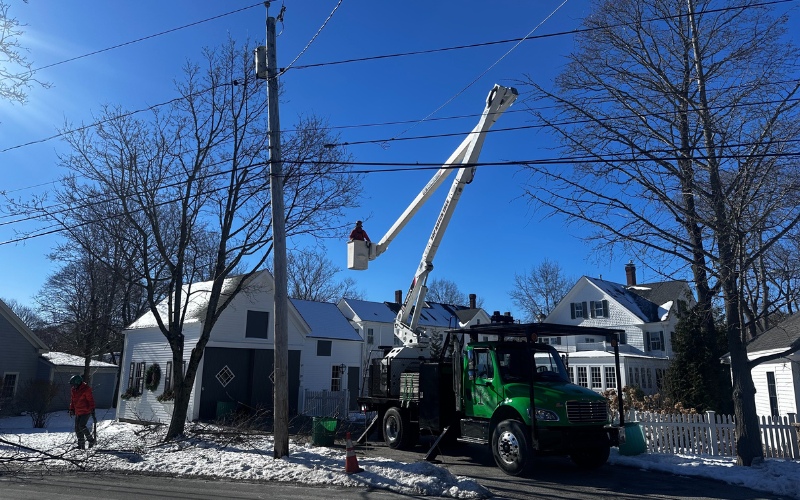
Professional crown raising maintains tree health while providing the clearance insurance companies require.
How to Resolve an Insurance Cancellation Notice for Overhanging Branches
If you’ve received an insurance notice about overhanging trees, you can usually resolve it with professional pruning – not full tree removal. Certified Arborists perform crown raising (also called selective pruning) to remove lower branches that encroach on roofs, driveways, or utility areas. This creates clearance that satisfies insurers while maintaining the tree’s natural shape and structural integrity.
PRO TIP: Understanding the signs of hazardous trees helps distinguish between trees that need pruning versus those requiring removal for safety reasons.
When Tree Removal Becomes Unavoidable
Tree removal is only required when the tree:
- Is dead or dying
- Has significant structural decay or damage
- Leans dangerously toward structures
- Has multiple large limbs that have already failed
Otherwise, proper pruning almost always resolves insurance concerns.
Why DIY Pruning Is Not Recommended
DIY trimming often violates insurer requirements because insurance companies need professional documentation and certification that work was performed correctly. Simply cutting branches yourself doesn’t provide the compliance proof insurers require.
Improper cuts create decay or instability that can void coverage entirely. Topping trees (cutting branches in the middle) or making flush cuts against the trunk creates entry points for disease and actually makes trees more dangerous during storms. Insurance companies may consider improperly pruned trees a greater risk than the original overhanging branches.

Professional equipment and certified expertise ensure safe, effective tree work that satisfies insurance requirements.
How a Certified Arborist Protects Your Policy
Instead of attempting the difficult and dangerous job of pruning overhanging branches yourself, work with an experienced arborist.
Professional Assessment and Documentation
TRAQ-certified arborists evaluate the actual risk level of your trees and recommend the minimal amount of pruning needed for compliance. They identify which branches actually pose risks versus those that simply look concerning to insurance drones, determine proper clearance distances based on tree species and growth patterns, and assess whether trees are healthy enough to keep or require removal for safety.
An arborist can provide before-and-after photos, detailed risk assessment reports, and maintenance documentation that insurers accept as proof of compliance. TRAQ (Tree Risk Assessment Qualified) certification means the arborist has specialized training in evaluating tree risk factors that insurance companies recognize.
Professional documentation often makes the difference between keeping your tree and being forced to remove it entirely. Insurance companies respond much better to certified assessments than homeowner photos or unqualified contractor estimates.
Pruning that Meets Industry and Insurance Standards
Professional crown raising differs from the discredited practice of tree topping. To prune the tree properly, arborists:
- Remove entire branches at proper cutting points
- Maintain the tree’s natural defense systems against decay
- Preserve the tree’s structural integrity and health
- Follow ISA standards that insurance companies recognize
South Shore trees face unique challenges, including salt spray exposure that makes them vulnerable to improper pruning wounds, coastal winds that require understanding of how branch removal affects wind resistance, and species-specific timing requirements for optimal healing. Professional tree pruning and trimming accounts for these local conditions.
For Tree City USA communities like Hingham, which has maintained this designation for 32 years, Tree Warden permits may be required for work on public shade trees, and Certified Arborists understand these local requirements.
“We’ve found that insurance companies respond much better when homeowners provide professional documentation. With over 25 years of serving the South Shore, we understand both what insurers need and how to keep trees healthy long-term. Coastal properties especially need crown raising techniques that account for salt spray and wind exposure.” – Jeff Van Meter, Top Notch Tree Owner
Professional pruning both satisfies insurers and preserves property value by keeping mature trees healthy for decades rather than creating problems that require expensive removal later.

Expert pruning work requires specialized training and equipment to ensure both safety and compliance with insurance demands.
What to Do Next After You Receive an Insurance Notice
- Contact Your Insurance Provider: Call the customer service number on your policy (not any number provided in the notice) to verify the requirement is legitimate and understand exactly what clearance they need.
- Schedule an Inspection with a Certified Arborist: Most notices allow 45-60 days for compliance, but scheduling during busy storm seasons may require immediate action. Request a written assessment of what work is actually needed.
- Get Written Documentation of the Work Performed: Ensure your arborist provides before and after pictures, detailed work reports describing what was done and why, and copies of their certifications. This documentation protects you from future policy challenges.
- Submit Proof of Compliance to Your Insurer: Send the complete documentation package to your insurance company and request written confirmation that the work satisfies their requirements. Keep copies for your records.
- Plan Ongoing Maintenance Pruning Every 2–3 Years: Storm damage prevention pruning and maintenance pruning programs prevent future insurance compliance issues by addressing problems before they trigger new cancellation threats.
Following this process protects both your insurance coverage and your property investment while maintaining the mature trees that enhance your South Shore home’s value.
Frequently Asked Questions About Insurance Tree Compliance
Will my homeowner’s insurance cover the cost of crown raising if it’s required for policy compliance?
Unfortunately, most homeowner’s insurance policies consider crown raising “maintenance” rather than covered damage, so it’s typically an out-of-pocket expense. However, some policies may cover tree work if it’s performed to prevent imminent property damage. The cost of compliance is usually much less than the increased premiums or deductibles you’d face with a new policy.
What happens if I ignore the insurance company’s tree trimming requirements?
Ignoring insurance requirements typically results in policy non-renewal or cancellation, leaving you to find new coverage in a challenging market. Alternative insurers often charge significantly higher premiums and may require even more extensive tree work. Acting promptly on compliance notices protects both your coverage and your options.
Can crown raising be performed year-round, or are there restrictions for emergency insurance compliance?
While the best time for tree pruning on the South Shore varies by species, emergency insurance compliance work can be performed year-round when policy cancellation is threatened. However, some species may require follow-up care or monitoring when pruned during vulnerable periods like late spring growth or extreme weather.
Keep Your Trees, Coverage, and Peace of Mind with Help from Top Notch Tree
Don’t let insurance pressure force you into hasty decisions that could damage valuable mature trees or create greater risks. With over 25 years serving the South Shore, Top Notch Tree understands both insurance requirements and the unique challenges of maintaining healthy trees in coastal environments.
Whether you’re facing immediate compliance deadlines in Cohasset Village or proactive maintenance needs for waterfront properties in Scituate Harbor, call us today at 781-412-1862 or request an estimate online to discuss how professional crown raising can resolve your insurance concerns while protecting your investment in mature trees.

